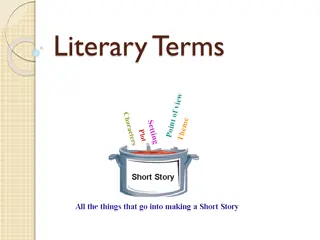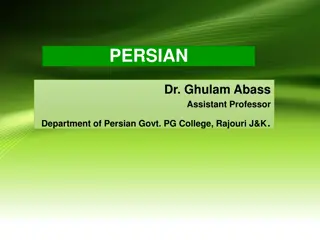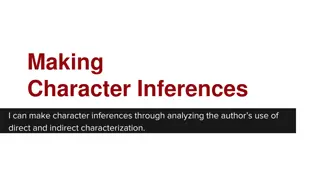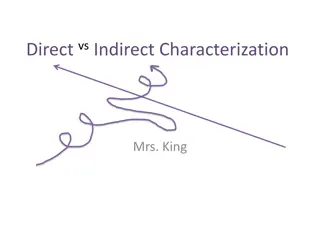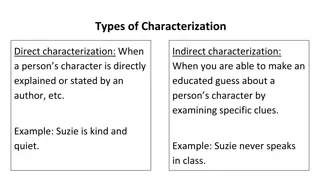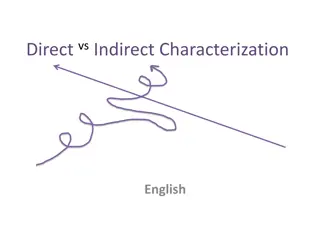Understanding Characterization Techniques in Literature
In literature, characterization is essential for creating realistic and relatable characters. Authors use direct and indirect techniques to reveal the personalities of their characters. Direct characterization involves straightforward description of traits, while indirect characterization relies on actions, speech, thoughts, and interactions to convey character traits subtly. Effective characterization enhances reader engagement and connection with the story.
Download Presentation

Please find below an Image/Link to download the presentation.
The content on the website is provided AS IS for your information and personal use only. It may not be sold, licensed, or shared on other websites without obtaining consent from the author. Download presentation by click this link. If you encounter any issues during the download, it is possible that the publisher has removed the file from their server.
E N D
Presentation Transcript
Direct and Indirect Characterization Ms. Bumgarner English 10
Think About It A new student comes into class. How do you form opinions about the new student and his/her personality?
Characterization Definition: The process by which the writer reveals the personality of a character. Two types: Direct and Indirect
Effects of Characterization If you ve ever read a book or watched a movie and really cared about what happened to the characters, they have been characterized well. Poor characterization can make a character uninteresting because that character may lack focus and clarity. We don t care about characters we don t know well. Good characterization creates a clear picture in the reader s mind. Characterization is what makes fictional characters real to us.
Direct Characterization When the narrator states facts about a character s personality. Ex. The patient boy and quiet girl were both well- mannered and did not disobey their mother. The author is directly telling the audience the personality of these two children. The boy is patient and the girl is quiet. Both are well-mannered. When an author uses direct characterization, the reader doesn t have to do any detective work
Indirect Characterization When the author reveals a character s personality through details of speech, thoughts, interactions with other characters, actions, and looks Speech Thoughts Effects on others (relationships) Actions Looks (appearance) Writers usually prefer to use indirect characterization. By showing their characters in action, readers get to decide for themselves what a character is like without the
Indirect Characterization What does the character say? How does the character speak? Speech What is revealed through the character s private thoughts and feelings? Thoughts What is revealed through the character s effect on other people? How do other characters behave in reaction to the character? What does the character do? How does the character behave? Effect on others toward the character (relationships) Actions What does the character look like? How does the character dress? Looks (appearance)
Speech The exact words of a character give us insight into that character s personality. Harry, show your talents! barked the instructor. Don t hold back this time! The way a character says something (i.e. accent, word choice, slang, etc.) can also reveal personality traits. I do not have the time, she said, but perhaps you could consult your timepiece.
Thoughts A character s thoughts and feelings reveal information about what that character is like Frank insisted he wasn t tired or hungry, but really he was both. The long plane trip, with two delays, had left his patience in shreds. However, he didn t want Aunt Judy to go to any trouble. What kind of person do you think Frank is? How do you know?
Effect on Others (Relationships) How one character reacts to another character often reveals qualities of both characters Note what characters say to each other and how characters act toward each other Michael hugged Annie before he got out of the car. I ll call you tomorrow, he said. She smiled and replied, You always say that, and you never do! He laughed. Okay, I ll e-mail, then. You d better! Annie grinned, but her eyes were sad. What does the conversation reveal about each character s personality?
Actions Actions speak louder than words right? Actions reveal a great deal about people. For example, actions can tell us whether a person is or mean and mocking helpful and encouraging A characters actions can tell us personality, motivation, or situation.
Actions It was a cold October day when Kristi s alarm buzzed at 6:00 a.m. She pulled on her clothes and headed for the door. She carefully adjusted her headphones; then she pulled the sleeves of her turtleneck over her hands to keep out the cold. Here goes 10 miles, she thought as she began her run. I have to be ready for the spring marathon. What actions does Kristi take? What do these actions tell us about her?
Looks (Appearance) Through exact physical details, a writer can imply, or suggest, a character s personality. How is the character dressed? What is the character s posture? What is the character s facial expression? The man standing at the door had short hair,piercing eyes, and a serious gaze. He was dressed neatly in a starched, white shirt and striped tie.
The study of character development should be fun! The study of character development should be fun! But, how do you know if an ending is truly good for the characters unless you've traveled with them through every page? -Shannon Hale





